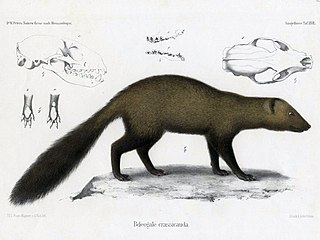The term "big cat" is typically used to refer to any of the five living members of the genus Panthera, namely the tiger, lion, jaguar, leopard, and snow leopard, as well as the non-pantherine cheetah and cougar, and sometimes the clouded leopard. However, only the first 4 of these species are able to roar.

A genet is a member of the genus Genetta, which consists of 14 to 17 species of small African carnivorans. The common genet is the only genet present in Europe and occurs in the Iberian Peninsula, Italy and France.

Bdeogale is a mongoose genus that was proposed by Wilhelm Peters in 1850 based on a mongoose specimen collected in Mozambique. Bdeogale species have compact paws with four symmetrical toes, round ears and a blunt muzzle with a broad round and bare rhinarium. The genus contains four species that are primarily terrestrial and omnivorous and forage in dense vegetation.

A least-concern species is a species that has been categorized by the International Union for Conservation of Nature (IUCN) as evaluated as not being a focus of species conservation because the specific species is still plentiful in the wild. They do not qualify as threatened, near threatened, or conservation dependent.

A species that is extinct in the wild (EW) is one that has been categorized by the International Union for Conservation of Nature as known only by living members kept in captivity or as a naturalized population outside its historic range due to massive habitat loss.

The Viverrinae represent the largest subfamily within the Viverridae comprising five genera, which are subdivided into 22 species native to Africa and Southeast Asia. This subfamily was denominated and first described by John Edward Gray in 1864.

Bourlon's genet is a genet species native to the Upper Guinean forests. It is known from only 29 zoological specimens in natural history museum and has been described as a new Genetta species in 2003. It is listed as Vulnerable on the IUCN Red List as the global population is estimated at less than 10,000 mature individuals.

Dama is a genus of deer in the subfamily Cervinae, commonly referred to as fallow deer.
Petracola is a genus of lizards in the family Gymnophthalmidae. The genus is endemic to Peru.
Petracola angustisoma is a species of lizard in the family Gymnophthalmidae. It is endemic to Peru.
Petracola ventrimaculatus, the spotted lightbulb lizard, is a species of lizard in the family Gymnophthalmidae. It is endemic to Peru.
Petracola waka is a species of lizard in the family Gymnophthalmidae. It is endemic to Peru.

Urva is a genus comprising the Asian mongooses within the mongoose family Herpestidae. Species in the genus were formerly classified in the genus Herpestes, which is now thought to comprise exclusively African mongooses; phylogenetic evidence indicates that the Asian mongooses form a monophyletic group and had an Asian common ancestor. Urva forms a clade with Xenogale and Atilax, while Herpestes forms a clade with all other African mongoose species.








